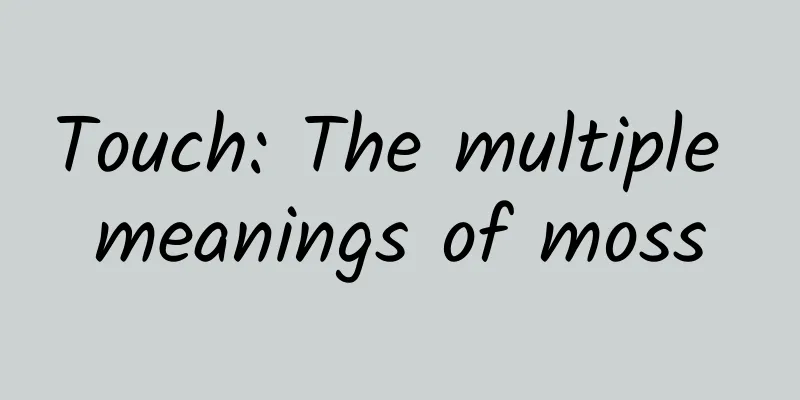Touch: The multiple meanings of moss

|
Moss-covered trees in Devon, England. © Adam Burton/Alamy Leviathan Press: Traditional Indians living in extremely cold environments are experts in using moss. They use moss to wipe the mucus off salmon, or stuff dry moss into gloves, shoes, and even cribs to keep warm, apply it to wounds to stop bleeding, and stuff it into pillows to help sleep... In the dead polar regions, moss is a precious daily necessity that is readily available. But most of the time, moss is the most easily overlooked plant. It is tiny, plain, and simple, but it supports the operation of the forest with its vast existence. The best way to observe moss is not to look at it, but to touch it. Note: The word "moss (Bryophyta)" in the original text should strictly be translated as "moss plants", which is one of the three groups of bryophytes. This article translates it into the word "moss" based on Chinese habits. One day in the early winter of 2021, I went for a walk in the woods near my home in Oxford. Next to a bench overlooking the city, I stumbled upon a mossy log, gleaming green in the overcast sky. The leaves of the moss were as fine as the finest embroidery and as thin as cling film. I brushed my fingertips over the featherbed, marveling at its subtlety and complexity, and immediately took a bunch of photos. When was the last time I touched moss? And when was the first time? I remembered trees, rivers, mountains, but not moss. But that day, I felt as if the moss was calling me, calling me to pay attention to its rigor and beauty hidden among its larger tree cousins. © Milwaukee Journal Sentinel Or rather, what moss represents to me. I have been thinking about the meaning of touch, and how long it has been since I touched nature. I live in a city with parks and meadows everywhere, but I don’t touch nature enough; I just look at it - ornamental birches, canals, roses in hedgerows. In the summer, I swim with friends, or sunbathe, roll on the beach and grass, but as soon as we return to our clean homes, I am out of touch with nature again. I seek nature in small doses, just the right amount, and in a wholesome way. Winter is the only season when you can really touch nature. In winter, no matter how you wrap yourself up, a raindrop will find you. The mist will envelop you, leaving its moisture on your face. The dry, cold air will crack your lips. The mist will touch your nostrils and the inside of your throat when you inhale. You will feel winter touching the back of your ears. Winter's presence is everywhere. But it is the moss that works the hardest in winter, growing and glowing on every log, between every rock, and in every crack. Day after day that winter, I touched moss everywhere in the city: on sidewalks and walls, on the bark of willow trees, on metal manhole covers, on tombstones, on houseboat roofs, on abandoned bicycles, under railroad bridges. Moss likes to grow anywhere there is enough shade and moisture. © Tenor As a nonvascular plant, it lacks an elaborate rhizome structure; it has no parts that could be called roots. Mosses absorb water and nutrients from their single-cell leaves, which are ingeniously designed to retain 30 times their weight in water. If you ever stop to stare at a moss in the winter and touch its surface, it feels like you've touched a wet sponge. You'll also realize that while it may feel soft at first touch, there's a world of textures hiding there. © TABLE Debates As I carefully run the back of my finger over the moss, tiny stem-like structures tickle me. These stems emerge from the moss fronds and are called sporophytes, each of which ends in a sporangium. Mosses reproduce when wind and water carry these spores away from their source. The sporophytes grow much higher than the moss layer, allowing the spores to travel far and start a new colony, a new family. One of the most common mosses in urban settlements is Toutula muralis, or wall spiral. Like most beginners, this was the first moss I noticed. One day, under a clear blue sky after a rain, I observed that the spores of a cluster of Toutula muralis growing on a brick wall had swelled to three times their normal size. This surprised me, and I thought it might be another stage in their growth cycle that I had not read about. I knelt on my knees, eye level with the wall moss, and extended my fingertips toward the spores; but my hand stopped midway. It took a moment for my eyes to adjust, and I realized that the spores had not swelled at all. Instead, a drop of water was trapped around each spore, like a miniature water ball or a pregnant belly. Many minutes passed, and it began to rain again. More rain fell, seeping through the moss. I remembered that I had things to do, but they seemed a little ridiculous, even insignificant, in front of a layer of moss. This was the first lesson the moss taught me: you can touch time. Not our human time, not even mammal time, but the time of the Earth. When I returned from my errands in the city a few hours later, the spores were still there, still clinging to the water droplets. Normally, a layer of moss takes 25 years to grow an inch thick . But mosses have been around for at least 350 million years, among the first species to come to land from water: as Robin Wall Kimmerer reminds us in Gathering Moss, moss is our elder. It is the species with whom we share our cities and apartments, a witness to human time and its catastrophic pace. If only the touch of the moss were enough to allow us to experience its rhythm of time. © PlantSnap *** Aristotle considered touch to be the most universal of sensory perceptions. Lately, I’ve come to believe that touching nature may be the most powerful way to reconnect with it. Some research suggests that activities that involve touching nonhuman entities with our bodies—such as walking barefoot[1] or swimming[2]—may help us cultivate emotional and ethical relationships with the nonhuman world. Phenomenologist Maurice Merleau-Ponty spent his life thinking and writing about human perception. In his view, we understand the world through our body’s perception and proprioception. Although vision is important in this theory because we use it to judge whether an object is far or near, large or small relative to our body, touch is equally important, if not more important. Ancient brick walls covered with moss, Ruinas Santa María la Mayor, Misiones Province, Argentina. © Sebastian Jakimczuk/Alamy Touch redirects us to the fundamental condition of existence - to the necessity of the other, human or not. When we touch the other, we are at our most vulnerable, because we are always touched by the other. In his posthumously published work, The Visible and the Invisible (1964), Merleau-Ponty offers this analogy: When one of my hands touches the other, which hand is touching and which is being touched? We have eyelids, we can pinch our noses and cover our ears, but we do not have a natural protective layer of skin. We cannot shut off our sense of touch. To live as a human in this world is to live as a toucher, to touch and be touched at all times with every pore of our body. © House Digest Intuitively, the idea that touching nature can cross species boundaries makes sense. And is there anywhere in the plant kingdom that embodies touch better than mosses and their cousins, the bryophytes? Moss is all about touch. It doesn't dig into the skin of the creatures it touches. It also takes little from the host it touches: moss is not a parasite. Yet it softens trees, prevents soil erosion, and provides shelter to tiny animals that we hardly notice. It is in constant contact with the Earth and all its living things, including us. In rainforests and on city sidewalks, moss waves us a greeting. *** The touch of moss has fascinated many people throughout the 900-year history of my current home, Oxford University. But, as historian Mark Lawley points out, it wasn’t until the late 17th century that studies of British mosses alone began to emerge. One of the key figures in documenting the diversity of British mosses was the German botanist Johann Jakob Dillenius. Dillenius maintained his interest in botany while studying medicine at the University of Giessen (JLU), where he wrote his first major work, Catalogus plantarum sponte circa Gissam nascentium (1718). In this book, he grouped several species of mosses and fungi under the heading of "cryptogams", a term for plants that reproduce by spores, also known as "lower plants". Botanist Johann Jacob Dillenius (1684-1747). © Wikimedia Perhaps few botanists would have taken the time to touch the ground with their hands, where other people had walked and animals had excreted. But Dillenius did it, and his work impressed the famous British botanist William Sherard. Sherard had just collected a large number of plants from Smyrna (now Izmir, Turkey), and was looking for someone to help sort them out. He offered Dillenius a job in his garden in Eltham, outside London. In 1721, Dillenius moved to England, where he set about cataloguing Sherard's plant collection, studying British mosses, and beginning an illustrated catalogue of British plants. During his first seven years in England, Dillenius lived alternately in Eltham and back in his London residence. In 1724 he published his first completed book in England, the third edition of Synopsis methodica stirpium Britannicarum, which had been originally published in 1670 by the Cambridge botanist and naturalist John Ray. In the second edition of 1696, Ray had listed 80 species of mosses, and according to George Claridge Druce, Dillenius added 40 fungi, over 150 mosses, and over 200 seed plants. Dillenius divided cryptogams into "fungi" and "mosses", but excluded ferns and horsetails. This was perhaps the first time that anyone had paid such detailed and unique attention to the “lower plants.” I was fascinated by the thought of an 18th-century gentleman touching and collecting English mosses day after day, year after year. We know very little about Dilenius’s inner world, but his letters show that he loved mosses and enjoyed living in their company. As for being among the English? Not so much. Wistman's Wood National Nature Reserve, Devon, UK. © Mike Read/Alamy After three years of rigorous work, his revised version of Ray's Outline was published, but without his name. His publisher (and Sherrard) feared that the British people would not like to see a foreigner's name on a book about their own mosses. In a letter to Richard Richardson, another famous British botanist and Dillenius's colleague, Dillenius said that his anonymous Outline had been published and expressed regret that he had not had the opportunity to publicly dedicate the book to Richardson. Despite this shortcoming, Dillenius hoped that Richardson would persuade Sherald to let him continue his dream of writing a history of mosses. He wrote: "I mean the History of Mosses, if I can find time to finish it...will you please...persuade him to let me devote one day a week to it." It was not until 1732 that Dilenius found the one day a week he needed to write his history. Although Dilenius enjoyed compiling the catalog, his real passion was for the lower plants. For about four years, he worked on Sherard's catalog, hoping that he would one day be free to devote himself to mosses. When Sherard died in 1728, Dilenius's fate changed overnight. Sherard left his books and plants to Dilenius, and a large sum of money to keep a professorship in botany at Oxford. In his will, he named Dilenius the first Sherard Professor. In 1728, Dillenius moved to Oxford, where he lived until his death. In Oxford, James Sherard, the brother of his former patron, showed contempt for Dillenius, demanding that he stop studying mosses and compiling illustrations and forcing him to write a book about Eltham Gardens, Hortus Elthamensis (1732), which caused Dillenius to suffer huge financial losses. Illustration from The History of Mosses (1741). © AbeBooks After writing The Garden, Dillenius devoted his career and life to the study of mosses, publishing Historia Muscorum in 1741. This meticulous book, which is over 576 pages long and contains 85 full-page illustrations, describes in detail 661 taxa of lower plants, including mosses, fungi, lichens, algae, liverworts, dimes, and lycophytes. He divided mosses into six genera: lantern mosses, gray mosses, golden mosses, true mosses, sphagnum mosses, and lycophytes, and these classifications are still useful today. Although this book was his life’s mission, it was not well received in the market. Soon after, he started to write an abridged version of it, thinking that if he sold it at a lower price, people might want to buy it, but by then someone had beaten him to it. More than 10 years earlier, his Italian contemporary Pier Antonio Micheli had written a detailed book on cryptogams, which was considered the pioneering work in the field. In 1747, Dilenius died of a stroke at his home in Oxford, and the abridged version of The History of Mosses was never published. The saddest part of Dilenius’ story is that, even today, he is generally considered “one of the continental botanists who contributed to the history of British bryology.” He was not admired in his native Germany or in England, where he lived and was buried. His fate was that of an immigrant. Dilenius was a stranger to me, but I became a friend to him, and I carried his marvelous illustrations with me as I walked along the Thames, and in his company I learned to distinguish between a golden moss and a lantern moss. I've always enjoyed gazing at trees and listening to the wind in the woodlands, but paying attention to moss requires a conscious redirection of my thoughts and senses. Moss doesn't jump out at you, it doesn't draw you in the way a pine needle or an oak branch might; even if it looks fantastic, it doesn't hold you in long enough to observe its details. Why, I wondered, would a man like Dilenius, a rather unwelcome immigrant like him, devote all his energy and hope to a plant we tend to ignore? As a historian, I can’t help but list several reasons: the rise of the scientific worldview, colonialism, the urge to categorize the plant and human worlds, the founding of the botanical garden in Giessen in 1609. All of these may be true, but the question remains: why moss? Why this person? Something is always missing from the archive. *** Growing up in a rain-soaked town in Punjab, India, I spent much of the year wading through mud and blocking rainwater to reach the corner store near my home. During the monsoon, when the sky poured with rain and rumbled with thunder, I would play catch with my friends in the community park. I remember slipping on rocks covered with kai. I remember the bruises we got. We would slip on kai twice, sometimes three times in an innings. In Punjabi, kai doesn't exactly mean moss. We don't classify lower plants into groups like "bryophytes" based on how they reproduce. Ancient texts of Ayurveda, a traditional medical system in northern India, such as the Susruta Samhita and the Caraka Samhita, divide plants into different categories based on their shape, texture, appearance, medicinal properties and where they grow. Especially near the ground, any plant that could make you slip, fall, or both is called a kai. When we talk about seaweed, lichen or slippery moss on rocks, we use the phrase "pathar utte kai jammi hoyi hai". This phrase has at least two meanings. Roughly speaking, it means: "moss is frozen to the stone" or "moss is born from the stone" . Rocks are to moss what soil is to trees. I don't mean to romanticize things, but I doubt that scraping and selling moss will ever be a thriving business in Punjab. © Rural Sprout Yet in the UK, moss is used to decorate homes, airports and hotels. Sphaghum moss, also known as peat moss or bog moss, is used to increase productivity in gardens; its habitat is home to rare wildlife and carbon reserves, but its uses in horticulture are surprisingly large. In the maze of world political economy, Punjab is primarily a site for agricultural experimentation and extraction (not consumption). But I wondered, beyond that, whether language played a role in the formation of these very different attitudes toward mosses? In English, moss is to be "carpeted" over a garden. Embedded in the language is the idea that moss is a decoration, a beautiful addition to the natural world. The word "carpet" comes from the Latin "carpere," which means "to pull into pieces." To carpet something is to pull and cover it, and to cover and pull and cover it, and these two actions seal the fate of the moss. Icelandic moss in Scotland © Murdo MacLeod/The Guardian In the centuries after Dilenius’s death, mosses were pulled from around the world to cover other worlds. Colonists seized and exploited indigenous peoples, foreign lands, and ecosystems in the name of science and civilization. Science historians such as Patricia Fara and Zaheer Baber have demonstrated that botanical expeditions by British and European scientists such as Joseph Banks helped consolidate Britain’s imperial power. Botanists accompanied colonial officials on expeditions around the world, acquiring economically and culturally relevant botanical and agricultural knowledge through collecting activities around the world, including India. In the 1780s, John Sibthorp, the third Sherard Professor of Botany at Oxford, traveled to Greece and present-day Turkey to observe and collect lichens. In April 1795, Sibthorp traveled to Cardamoula (present-day Kardamyli, Greece). Commenting on his journey, he wrote: "Human nature seems to have recovered its upright form here; and we no longer see the servility of body and mind which was so evident in the Greeks when they were conquered by the Turks." This was an age of colonialism and Orientalism, and the Sherrard Professors of Botany were no exception. Modern botany, with its near-global dominance, owes much to the opportunities provided by colonialism. The scientific collection or extraction of plants, which took place simultaneously with the conquest of peoples, meant that the colonists touched everyone. Robert Clive’s first visit to India in 1744, just a few years before Dillenius’s death, arguably determined the course of British colonialism in the subcontinent. By 1794, when Sibthorpe wrote his Flora Oxoniensis, the most valuable historical record we have of Oxfordshire’s flora, the East India Company had established itself in India. The modern history of touching moss is a history of elitism, colonialism and racism. As I walked around Oxford, touching moss within ancient walls, cobbled streets and gated colleges, I realised that touching moss is never a question of whether or not, but a question of whether or not. In 19th-century Britain, there were many working-class botanists, men and women, who taught themselves botany by reciting the Latin names of plants in the pub after long hours of backbreaking work. But the idea of studying botany in public was utterly scandalous and horrifying to the elite. Although workers’ botany was widespread in Manchester and Lancashire, it never made it to the spires of Oxford. In the British colonies, colonialism turned touch into a privilege. Although the colonists employed native people to perform the act of touching on their behalf, they reserved the right to know what the “natives” were touching: mosses and the world beyond humans. They also denied any emotions and feelings that humans might have for nonhumans. A plant becomes an object to be scrutinized. A piece of moss becomes just a rug to be scraped and examined. You touch the moss, take it home, and examine its structure under the university's new microscope. You touch the moss without really touching it. © Quark Science When I touched the moss again, I no longer felt at one with nature. I felt disconnected. No more pure touch. No return to an untainted relationship with nature. No more moss rhythm. Between my fingertips and the moss spores were centuries of exploitation and seizure, and behind them were human hands and too many human touches. *** While writing this article, I often visit an ash tree near my home. On its trunk, two types of mosses have begun to grow: Ovalleafed Beautybeak and Wave-leaved Crane Moss, the latter of which is a moss with star-shaped leaves. I touch them every other day, but I don't know what to think about them, how to talk about them. I want the moss to tell me its story. It is quiet, humble, peaceful, and silent. It may be absurd, even foolish, to think that there is any redemption in touch. If touch itself as an intersubjective perception has become corrupted, what is left of our bodies and selves that are always touching others? I want to overturn that interpretation. Because beyond the history of touch there is another kind of touch: the existential, unstable, fleshy nature of the human capacity to touch others. It’s the kind of touch that kept Dilenius alive when things were going badly at Oxford. In 1790, in a history of English botany, the writer Richard Pulteney called Dilenius a “recluse,” and a correspondent described him as “busy with drawing mushrooms.” Busy touching nature. Touch is a lingering reminder of the violence inherent in the body. Touch takes us back to a rocky past. As a kid, my friends and I used to play the game of touch and run, where the whole premise is one person chases the others, trying to touch them. You have to walk that fine line between running at your friend with all your might and hurting them with your eager hands. It wasn't easy, and we got hurt a bit, but we figured out a solution: your touch only counts if you don't hurt anyone. © Björn Forenius/Getty Images/iStockphoto Touch is a careful hand. The flesh of touch exposes us to others—human and nonhuman, but also ourselves. Merleau-Ponty argues that the act of touch constitutes the perceived and the perceiver. In touching the nonhuman, I am thrown into the world again and again, and each time I must reintegrate myself back into the state I was in before the touch. In this constant process of splitting and reintegrating, there is a generative moment in which I am not sure who I am, neither who I was nor who I will be. Am I human? Am I part of this world? Can I change? If, in the act of touching nature, I am not practicing an honest and unadulterated connection with nature, but rather a complicit, historical, and utopian touch, then perhaps touch can be reconceptualized as a complex, layered, and elastic sensory perception. Perhaps the opposite is true. Not as a one-dimensional, immediate delivery of experience in its own right, but as something we—our history and our present—design it to be. Perhaps the superficiality of touch is a fiction. The history of human-nonhuman relations may have embellished and categorized touch and its underlying foundational reciprocity, its calculations of the past and present. I wonder if I can cultivate and use touch—not as a cure for my alienation from the nonhuman world, but as a provocation to open up to that world and our own. The word touch comes from the Old French toche - to strike, even to attack. Touching is a form of prying. Just before spring arrived, I went for a walk in the woods. More logs had fallen. Wood moss, a type of moss with red stems and feathery leaves, shimmered on the forest floor. I thought of Séan Hewitt’s poem “Wild Garlic,” in which he writes: The world is dark But the stars shine brightly in the forest The sky was overcast, the moonless sky was dark, and I walked home feeling depressed. I pulled my keys from my coat and they fell to the ground. Under the streetlight, a patch of silver-green moss, Moss argentea, shimmered beneath my keys. The moss was the memory of the earth that lived at my doorstep. I had to welcome it in: I had to touch it, to let it disintegrate me. References: [1]www.tandfonline.com/doi/abs/10.1080/01426397.2021.1928034?journalCode=clar20 [2]www.tandfonline.com/doi/full/10.1080/14649365.2018.1534263 By Nikita Arora Translated by Kushan Proofreading/Sesame filling teeth gap Original article/www.theguardian.com/environment/2022/nov/03/the-many-meanings-of-moss This article is based on the Creative Commons License (BY-NC) and is published by Kushan on Leviathan The article only reflects the author's views and does not necessarily represent the position of Leviathan |
<<: Is there only gas on a gas planet? If we want to land on Jupiter, can we do it?
>>: "Avatar 2" is released! The story behind the movie is really "terrifying"!
Recommend
Tea Science | From "Six Drinks" to "Tea Drinks", how did tea culture change during the Wei and Jin Dynasties? (Part 1)
Lu Yu's "The Classic of Tea - Seven Thin...
Online influencers selling products will soon be eliminated, and street stalls are the new traffic entrance for short videos!
Why do we say that the online celebrity purchasin...
WebViewJavascriptBridge-Bridge between Obj-C and JavaScript
[[138163]] WebViewJavascriptBridge is an iOS/OSX ...
Why has this water conservancy project, which was first built during the Warring States Period, benefited mankind for two thousand years?
After visiting Dujiangyan and Qingcheng Mountain,...
Save my life, the sushi in the refrigerator actually glows!!
Some time ago, I was surfing the Internet and fou...
Three Lives and Three Worlds of New Media Promotion: No Peach Blossoms, Just Routine
Last weekend, I was going to go to the cinema to ...
Schrödinger's mung bean soup: red or green?
Mung beans have a long history in my country, and...
How to optimize Google search ad keywords?
I believe everyone knows the importance of Google...
Don't stay up late! The DNA in your body is constantly breaking down, and it can only be repaired if you get enough sleep!
Expert of this article: Zhao Wei, MD, associate c...
Juzi Classroom's "Lesson Compass" teaches you how to teach
Course Contents: 1. Course Introduction 2. What t...
Interstellar "Spring Cleanup": A Guide to Cleaning Up Space Junk
Three years ago, astronauts on the International ...
How to Become a Great JavaScript Programmer
[[138028]] When I was a teenager, my interests sp...
He lost his teaching position because of "not doing his job properly", but he became a master
Isaac Asimov showed outstanding creative talent s...
China Automobile Dealers Association: The auto dealer inventory coefficient is 1.40 in June 2024
On July 10, 2024, the China Automobile Dealers As...
Turning the computer off and on again does not equal restarting, don’t get it wrong!
Mobile phones have become our close "partner...









